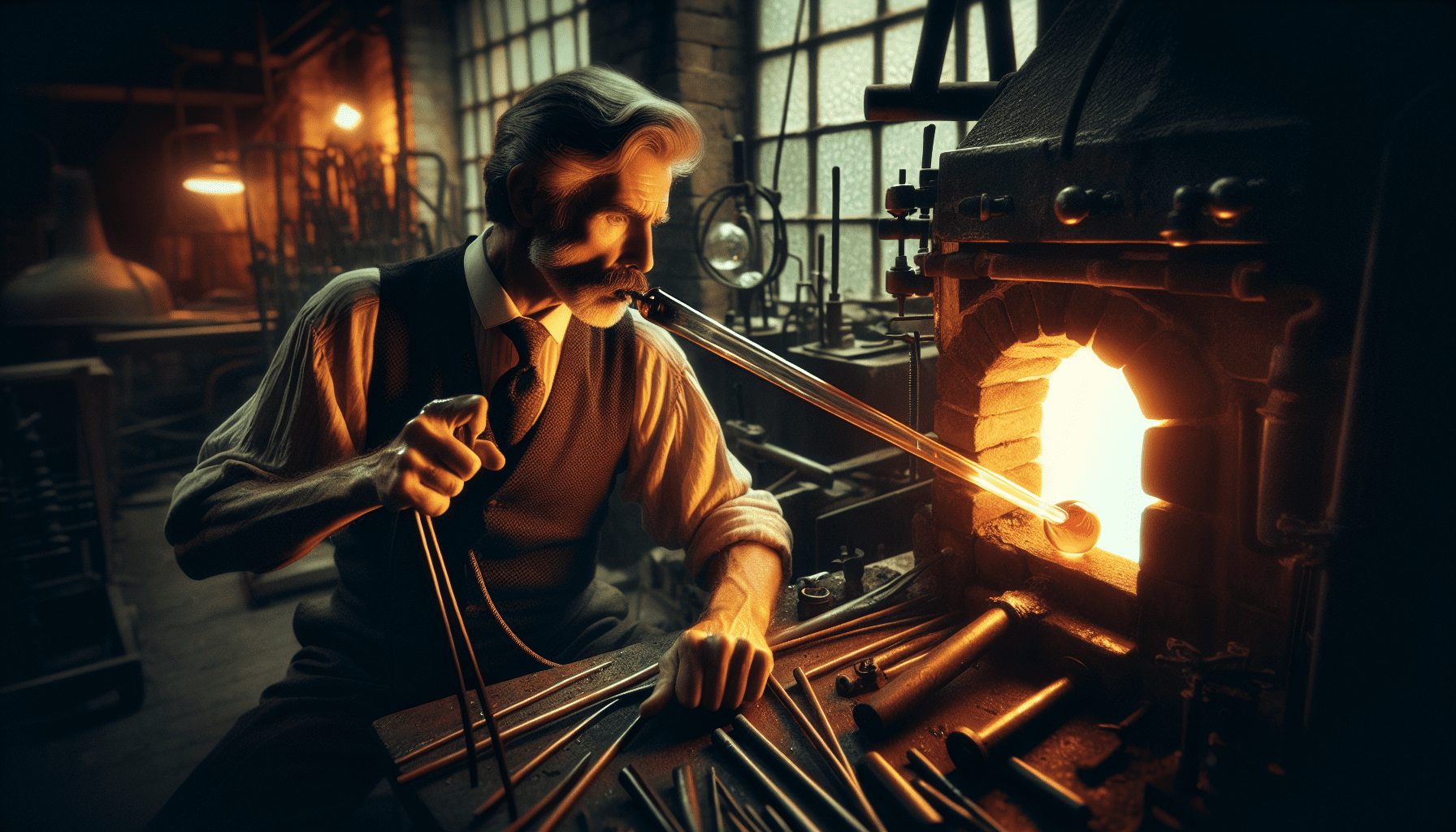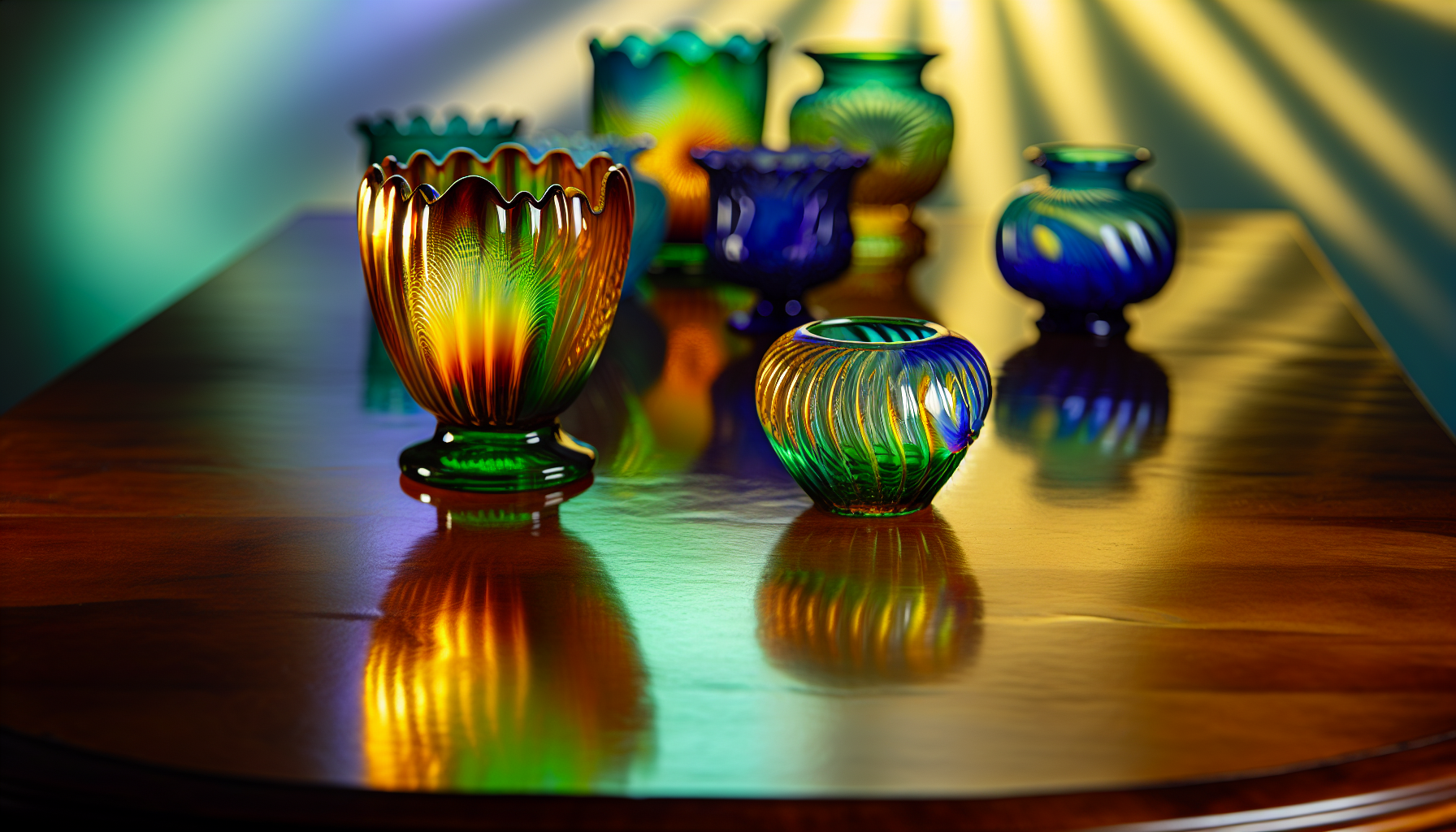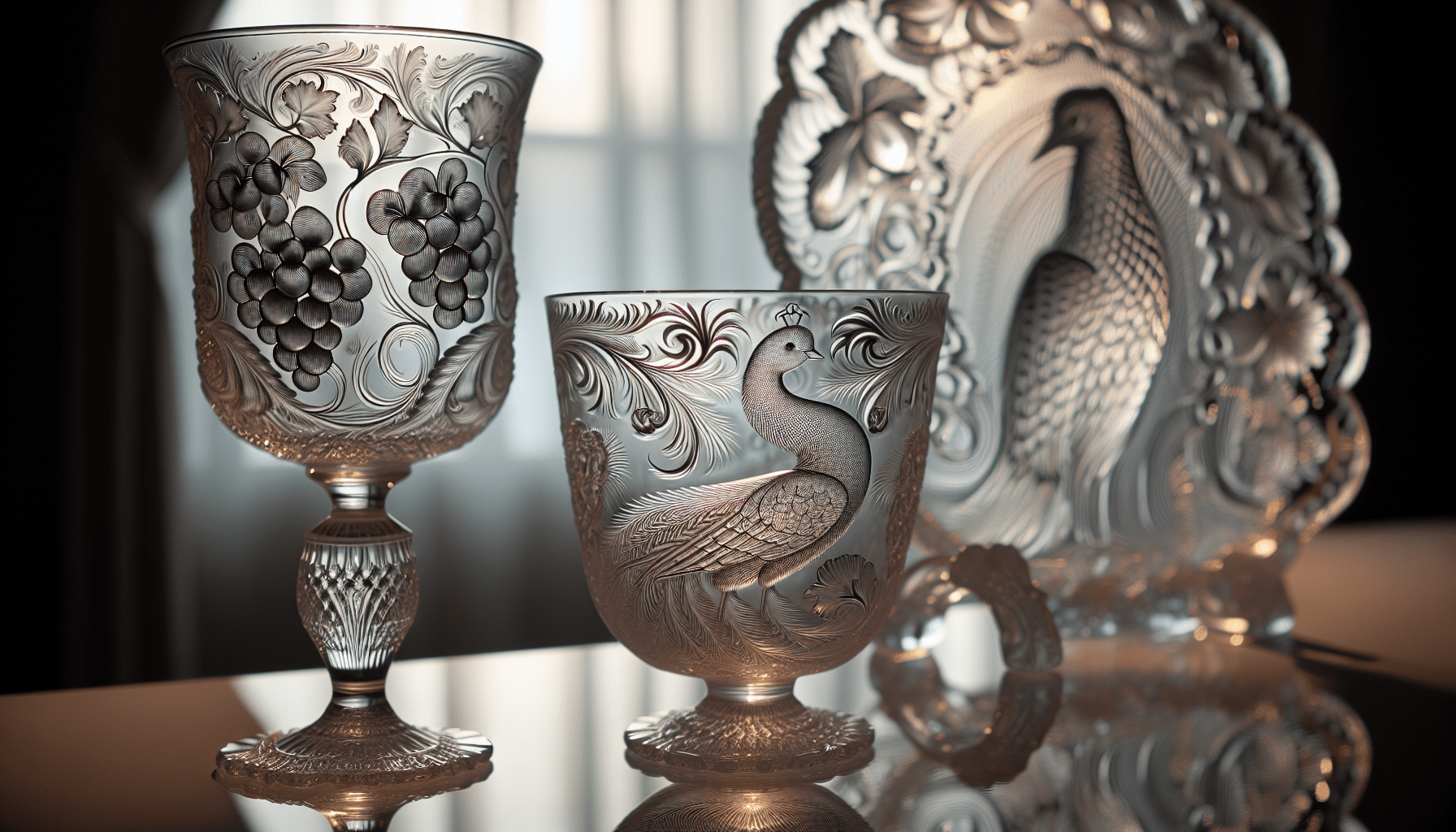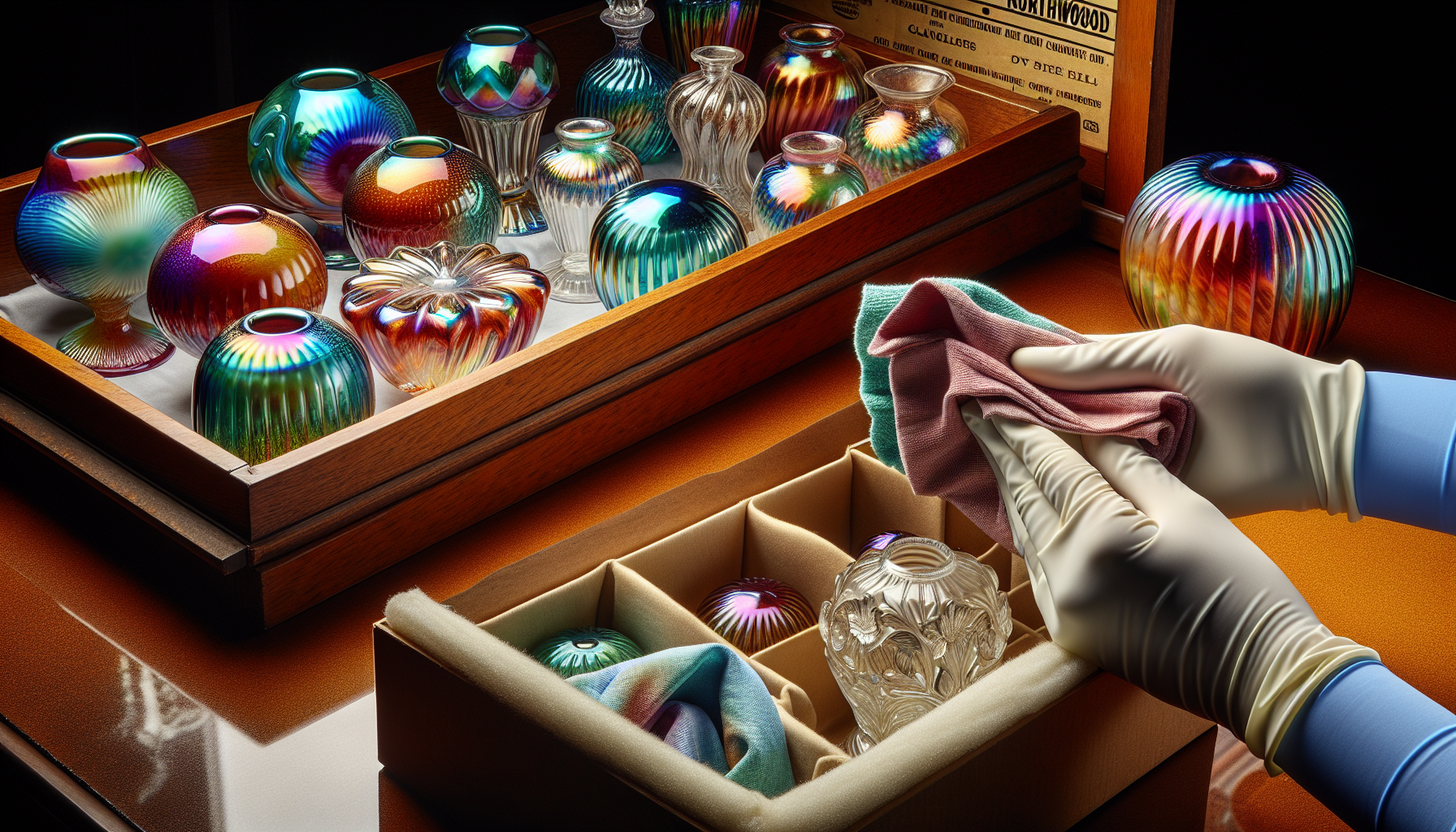Are you on a quest to distinguish the authentic, radiant pieces of carnival glass Northwood has to offer from mere imitations? This concise guide offers insight into Northwood’s iconic iridescent colors, signature patterns, and identification marks, showing you how to spot genuine Northwood classics in the colorful world of carnival glass.
Key Takeaways
Harry Northwood played a pivotal role in developing carnival glass, creating the unique formula and commencing production at his West Virginia factory, leading to a legacy that continues to define the glassware industry even after his death in 1919 and his company’s closure in 1925.
Northwood Carnival Glass is renowned for its vast spectrum of over 60 colors, with the original Golden Iris treatment establishing the brand’s reputation for color mastery, while diverse patterns and marks like the underlined ‘N’ aid collectors in identifying authentic Northwood pieces.
The rarity of certain pieces, such as those in ice blue and ice green hues, and the evident artistry in the mold-making and iridescent treatments underscore the enduring appeal and historical significance of Northwood Carnival Glass, which continues to be sought after by collectors today.
The Legacy of Harry Northwood and His Carnival Glass Creations

Harry Northwood, an esteemed figure in the realm of glassmaking, emerged from a lineage steeped in this craft back in England. His journey into the world of glass began early as he embraced apprenticeship before transitioning to America with ambitions to establish his prominence.
His brainchild, the Northwood Glass Company, quickly ascended as a beacon of industrial success by employing numerous workers and churning out copious amounts of glassware each week. It was within his West Virginia-based factory that Northwood pioneered carnival glass through an innovative blend devised under his guidance.
Although Harry Northwood’s life ended prematurely in 1919 followed by the cessation of operations at his company six years later, his influence endures vibrantly within the annals of glass craftsmanship history.
The Dazzling Spectrum of Northwood Colors

The Northwood carnival glass collection boasts a spectrum encompassing over 60 hues, featuring opalescent varieties like:
The traditional marigold
Rich amethyst
Vivid green
Blue custard, also referred to simply as blue
Striking red
Each hue presents its own unique appeal. Notably, Northwood set itself apart with exclusive shades including the iconic Golden Iris – a hallmark tint that has come to symbolize the brand.
Enhancing this kaleidoscopic array, novel colors such as Emerald and Azure were introduced into the assortment of carnival glass. This expansion led to an enthralling display of chromatic brilliance which continues to enchant aficionados of these radiant works.
Subsection: The First Carnival Glass Treatment
Northwood established himself as a master colorist in the realm of carnival glass with the introduction of an innovative treatment called Golden Iris. This remarkable achievement solidified Northwood’s standing and ushered in a new benchmark for carnival glass quality. His signature use of aqua opals along with soft pastel hues became emblematic within Northwood Carnival Glass collections, enchanting both collectors and aficionados.
Subsection: A Rainbow of Treatments
Northwood broadened its spectrum of colors beyond the Golden Iris hue, enhancing the aesthetic appeal of their glass items with additional carnival glass finishes. Introducing varieties such as Florentine, Perl, and Pomona enriched Northwood’s reputation as a pioneer in the field by diversifying the appearance of their glassware.
Identifying Northwood Pieces: Marks and Signatures
Carnival glass enthusiasts recognize the importance of distinctive marks to authenticate Northwood pieces. The Northwood mark, commonly an underlined “N” enclosed by a circle, stands as a hallmark for these cherished items. Harry Northwood also implemented his script signature on several works, offering additional proof of their genuine nature. Appreciating the origins of this mark is key in verifying the authenticity of each piece.
Although never formally copied or trademarked, these symbols have become quintessential emblems representing the esteemed Northwood brand. Diligence and discernment are required from collectors due to potential counterfeits that may mimic authentic markings. Thorough inspection is necessary to confirm veracity. The familiar northwoods-mark—an encircled “N”—serves as a guiding light for those seeking true collectibles while validating their value rests upon both that and recognizing articles bearing Harry’s cursive autograph.
Iconic Northwood Patterns and Designs

Delving into Northwood’s Carnival Glass collection, one is immediately struck by the array of mesmerizing designs and patterns. The prestigious reputation of their carnival glass is largely attributed to the unique hand-crafted nature of their pressed glass methods, encompassing a plethora of different pressed patterns. Among these intricate designs are notable ones such as:
Grape and Cable which debuted around 1909
Peacocks
Rose Show
Poppy Show
These motifs stand as testaments to Northwood’s expert mould creation abilities and commitment to manufacturing excellence.
Classic pieces like the Town Pump Exemplify this dedication, showcasing both iconic Northwood craftsmanship and outstanding design integrity.
Subsection: Novelty Items and Unique Finds
The ingenuity of Northwood wasn’t limited to conventional glassware, as the company branched out into creating a variety of whimsical novelty items. These pieces were characterized by their playful designs and served to diversify the Northwood collection with distinct elements such as the Bushel Basket figurine and the Town Pump.
Among these unconventional offerings were also Hatpin Holders adorned in the sought-after Grape & Cable motif, alongside Bon Bons featuring Butterfly patterns. Such items not only provided practical elegance, but also showcased Northwood’s commitment to superior craftsmanship and artistic quality in their glass creations—a trait shared by La Belle Glass Company.
Subsection: Vases, Bowls, and Beyond
The Northwood Company’s repertoire included more than just whimsical novelties. They offered an expansive selection of practical items like vases, bowls, and various others that featured the elaborate craftsmanship and varied styles favored by consumers of the era as well as modern-day collectors. Designs such as Tree Trunk on their vases, Stippled Rays embellishing their bowls, and Three Fruits adorning plates exemplify the breadth of artistic expression found in Northwood pieces.
To these items, the company also crafted mugs and pitchers adorned with a Singing Birds motif, demonstrating its capability for diverse design applications. For authentication purposes among collectors, genuine Northwood tumblers bear a distinctive marking: an underlined capital “N” encircled on their interior base.
The Rarity of Ice Blue and Ice Green Pieces

The ice blue, ice green, and cobalt blue shades of Northwood carnival glass are particularly distinguished by their scarcity and captivating appearance. These pastel hues were introduced to the range in January 1912, but were produced in such small quantities that they’ve become exceedingly rare and prized possessions among collectors.
Exceptionally sought-after items include the Grape Arbor water pitcher in ice green — with a known existence of less than five — and the Rose Show plate also in ice green, which is just as scarce. Similarly desirable is the Peacock at the Fountain punch set available in slightly greater numbers. Yet its distinctive coloration ensures it remains highly coveted.
The Artistry Behind Northwood’s Finest
Each Northwood Carnival Glass item is a testament to the intricate artisanship and expertise in mold creation. Noteworthy patterns including Peacocks, Poppy Show, and Rose Show were intricately designed to accentuate the splendor of pressed glass. These elaborate designs were purposefully crafted with an intent to augment the radiance bestowed by its lustrous coating, thereby enriching each piece’s tactile surface and ornate embellishments.
The signature shimmer of Northwood pieces was obtained by applying metallic salts like tin chloride to the hot pressed glass before subjecting it again to heat to fix this luminosity permanently. This iridescent finish brought forth more striking impressions on surfaces where heightened decorative elements could gleam with enhanced sharpness due mainly to these reflective treatments which improved every nuance within their engravings or embossments. The debut of the Golden Iris effect in 1908 proved pivotal for color innovation at Northwood. Giving birth to a distinctively warm marigold tint that imparted extraordinary brilliance and character into their creations.
Collecting Northwood Carnival Glass Today
Today, enthusiasts of carnival glass have the exceptional opportunity to acquire a piece of historical significance, appreciate the craftsmanship from bygone days, and secure an enduring heirloom through collecting Northwood Carnival Glass. There is a diverse assortment of Northwood carnival glass available for purchase that comes in an extensive variety of hues, designs, and shapes, providing ample choice to cater to varied aesthetic desires and collection inclinations.
Subsection: Where to Find Northwood Glass
Embarking on the quest for Northwood carnival glass is an adventure filled with excitement. Esteemed finds are scattered across multiple platforms, from brick-and-mortar antique shops to digital trading spaces and expert vendors. For both experienced connoisseurs and eager newcomers, the rush of stumbling upon a unique piece of Northwood glassware is unparalleled.
Subsection: Verifying Authenticity
Collectors of Northwood Carnival Glass must be vigilant in ascertaining the genuineness of their pieces. The American Carnival Glass Association is the guardian of the distinctive mark featuring an underlined ‘N’ within a circle, associated with Northwood glass, and they are proactive about taking action against any unauthorized use to uphold the integrity of this hallmark. For collectors seeking to authenticate their carnival glass items, utilizing antique guidebooks and other resources dedicated to this type of glassware can prove indispensable.
Being meticulous about specific details plays a crucial role when it comes to identifying true Northwood pieces. To assist with recognition, consider these points.
Genuine Northwood carnival glass tends toward being lighter in mass.
Typically, you’ll find that while iridescence characterizes most parts of an item from Northwood. Its base often remains non-iridescent.
Familiarity with pattern styles and rim motifs prevalent during particular eras will also aid in pinpointing the manufacture date for these collectible items from Northwood.
Preserving Your Northwood Carnival Glass Collection

After starting your Northwood Carnival Glass collection, understanding how to appropriately care for and preserve your pieces becomes crucial. Cleaning Northwood Carnival Glass requires a delicate touch. Here are some steps to follow.
Line your sink with a towel.
Use room-temperature water with mild dish soap.
Gently wash each piece separately with a soft cloth.
Rinse with room-temperature water to avoid temperature shock.
By following these steps, you can ensure that your Northwood Carnival Glass stays in great condition for years to come.
Proper storage and display also play a significant role in preserving your collection. Here are some tips to follow:
Store your pieces in a cabinet away from dust and dirt
Lightly dust using a soft feather duster
Avoid exposure to strong or direct sunlight to prevent fading of the iridescent sheen
When displaying your pieces, choose a stable, low-traffic surface to reduce the risk of breakage from accidental contact
Regularly inspect the condition of your pieces for any signs of wear, such as scratches or chips, and address these early to avoid further damage.
Summary
Within the realm of glass collectibles, Northwood Carnival Glass is a shining example of Harry Northwood’s artistic genius and inventive spirit. This type of glass is renowned for its unique color processes and elaborate designs, conveying tales from an age long past that still enchant collectors and admirers alike in contemporary times. Whether one is seasoned in the pursuit or just beginning to embrace this hobby, delving into the world of collecting and conserving Northwood Carnival Glass offers a gratifying adventure that links individuals with a profound legacy of artisanal skillfulness and aesthetic excellence.
Frequently Asked Questions
Is Northwood carnival glass?
Certainly, Northwood gained recognition for crafting carnival glass that is distinguishable by its shimmering hues and was often referred to as the “poor man’s Tiffany glass.” This variety of glass came in several finishes like Emerald and Azure, featuring foundational shades including green, amethyst, and cobalt blue.
Is carnival glass worth any money?
Indeed, carnival glass can command a substantial value, with the more uncommon specimens fetching prices in the thousands of dollars range.
What’s the rarest color of carnival glass?
Some of the most valuable and scarce colors found in carnival glass are cherry red, ice green, and black amethyst. Identifying these hues can often lead to the recognition of rare specimens within this type of colored glass.
When did Northwood Glass close?
Northwood Glass closed in 1925, after the founder’s death led to the company’s receivership. The plant, known for tableware, employed 300 people before its closure.
How can I tell if a piece is authentic Northwood Carnival Glass?
For authenticating a piece of Northwood Carnival Glass, search for the unique manufacturer’s marks such as the capital N underscored and enclosed within a circle or a scripted autograph. Reference guides and materials on antique carnival glass should be consulted to ensure Confirmation.

